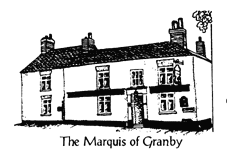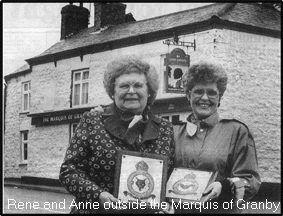THE
BEGINNING OF AN ERA
--
R.A.F.
STATION
BINBROOK
--
LINCOLNSHIRE
--
In the summer
of 1940 a Fairey Battle light bomber, piloted by Flying Officer Doug Gosman,
touched down on the grass strip that served as a runway at R.A.F. Station
Binbrook, opening a new chapter in aviation history.
This
was the first operational aircraft to land at Britian's newest airfield,
opened only days after the evacuation from Dunkirk, at a time when invasion
by the Germans seemed imminent.
Binbrook
went on to play a vital role in the final defeat of Germany, serving as
a base for Fairey Battles, then Wellingtons of 12 and 142 squadrons and
later the Lancasters of 460 Squadron, Royal Australian Air Force.
In 1908,
before anyone thought much about aeroplanes, Thomas Richard Cottingham
bought his farm, 500 acres of high level ground of Lincolnshire Wolds countryside.
When he died in 1917, his son Roland returned from serving with the Lincolnshire
Yeomanry in Palestine and took over the reins.
In 1938,
the Royal Air Force approached the Cottinghams who agreed to sell their
500 acres. R.A.F. Station Binbrook was then established.
The airfield
was one of a string planned as part of Britain's rearmament programme.
Unlike most of the war time R.A.F. establishments that sprung up in North
Lincolnshire, it had brick built hangers, substantial accommodation and
messes. Despite this, Binbrook lacked concrete runways and an unserviceable
airfield during wet weather hampered its operational ability until this
defect was corrected.
One of the first aircraft to
be lost from Binbrook was Fairey Battle L5568. On July 31, 1940, it was
one of six sent on what proved to be an abortive raid on German shipping
targets. On its way back, the Battle was attacked by British fighters near
Marblethorp. The crew of three were killed. These were dangerous days for
Britain, days when to shoot first and ask questions later was the unfortunate
consequence of constant enemy attacks. The crew of three were interred
in Binbrook's churchyard, sadly the first of many.
In November, 1940, Binbrook
began to convert to Vickers Wellingtons. This was a bigger, faster aircraft
that carries a much heavier bomb load.
Operations began seriously
on April 9, 1941. Emden was the target and one Wellington from 12 Squadron,
piloted by the C.O., W/C Blackden failed to return.
Constant involvement in operations
over Europe, including raids on Berlin, continued during 1941 and on April
1, Binbrook lost its 50th aircraft when a Wellington failed to return from
a raid on Le Havre.
July, 1942, was an appalling
month for Binbrook's crews. Seventeen aircraft were lost on raids on the
Ruhr and U-boat bases in Northern Germany. By September another thirty
one more had gone missing.
On the 26th September, contractors
moved in to start laying concrete runways so the Wellingtons moved to Wickenbyand
and Grimsby.
A decision had been made about
the new occupants. Australians.
It was towards the end of April,
1943, when the first Australian accents were heard in Binbrook's pubs.
Led by G/C Hughie Edwards VC, an advance party visited the base to make
preliminary arrangements for the transfer of 460 Squadron, R.A.A.F. from
Breighton, near York on May 14, 1943.
 Grimsby and Market Rasen were places to visit but none so popular as The
Marquis of Granby pub in Binbrook village. Rene Trevor ran the Marquis
of Granby throughout the war. She was the licensee but found herself thrust
into the role of "mother" to hundreds of young Australian airmen. She sewed
on buttons and new decorations, mended jackets and cooked meals for the
young men who flew the bombers from Binbrook between 1940 and 1945. The
youngsters who flew those aircraft never forgot Rene Trevor.
Grimsby and Market Rasen were places to visit but none so popular as The
Marquis of Granby pub in Binbrook village. Rene Trevor ran the Marquis
of Granby throughout the war. She was the licensee but found herself thrust
into the role of "mother" to hundreds of young Australian airmen. She sewed
on buttons and new decorations, mended jackets and cooked meals for the
young men who flew the bombers from Binbrook between 1940 and 1945. The
youngsters who flew those aircraft never forgot Rene Trevor.
She had been brought up in
Tealby where her father ran the Crown Inn for 43 years and it seemed natural
for Rene and her husband to go into the licensed trade themselves. This
they did in November 1939, just after their daughter, Anne, was born
Her husband was posted to the
Middle East and Rene was left to run the pub.
 The first airmen to arrive at the Marquis of Granby were the crews of the
obsolete Fairey Battles. Rene can remember them saying, "A real English
Pub with a piano -- can you play it?"
The first airmen to arrive at the Marquis of Granby were the crews of the
obsolete Fairey Battles. Rene can remember them saying, "A real English
Pub with a piano -- can you play it?"
Rene could and she could sing too. That started
a relationship between the Granby, its landlady and the boys of Bomber
Command.
Songs such as 'Cowboy Joe'
and 'Good night Sweet- heart' were to become familiar at the pub
throughout the war years.
Aircrew would walk or cycle
down to the Marquis every night they could for a pint or two of Holes Ale
(later Hewitts, Guinness or whatever else she could obtain) or
maybe she would serve her famous meal -- sausage, two eggs and toast, for
1s.6d.
She still remembers the day
the Australians moved in.
"My daughter Anne was about
three at the time and we had just begun to tell her about the war and about
the Germans. One day she came running in screaming, "Mummy, Mummy, the
Germans are here!" She had just heard an Australian accent for the first
time.
Despite the fearful odds
-- 460 Squadron lost more aircrew than any other in Bomber Command
-- many did complete their 30 trip tour of operations and on each
occasion there was another party in the back room of the Granby.
One of the traditions at these
parties was for the airmen who had successfully finished their tour, to
br held aloft while they wrote their names on the ceiling of the room.
Perhaps those names are still
there now under several coats of paint.
Mrs. Rene Trevor now lives
in a flat on Cleethorpes sea front. Over her fireplace hangs 460 Squadrons
Kangaroo and Boomerang crest baring the motto " Strike and Return".
"Oh, they were marvellous days.
They were wonderful boys and I knew just about every one of them."
And Binbrook village has not
forgotten. In front of St. Mary's church is a well tendered memorial to
460 Squadron. It is inscribed:-

.
.
460 SQUADRON
ROYAL AUSTRALIAN
AIR FORCE
--
TO THOSE WHO SERVED
BREIGHTON (YORK)
BINBROOK (LINCS)
FROM
15th NOVEMBER 1941
TO
2nd OCTOBER 1945
STRIKE AND RETURN
.
.
.
THE
END OF AN ERA
Back to the 460 Squadron home page...
 Grimsby and Market Rasen were places to visit but none so popular as The
Marquis of Granby pub in Binbrook village. Rene Trevor ran the Marquis
of Granby throughout the war. She was the licensee but found herself thrust
into the role of "mother" to hundreds of young Australian airmen. She sewed
on buttons and new decorations, mended jackets and cooked meals for the
young men who flew the bombers from Binbrook between 1940 and 1945. The
youngsters who flew those aircraft never forgot Rene Trevor.
Grimsby and Market Rasen were places to visit but none so popular as The
Marquis of Granby pub in Binbrook village. Rene Trevor ran the Marquis
of Granby throughout the war. She was the licensee but found herself thrust
into the role of "mother" to hundreds of young Australian airmen. She sewed
on buttons and new decorations, mended jackets and cooked meals for the
young men who flew the bombers from Binbrook between 1940 and 1945. The
youngsters who flew those aircraft never forgot Rene Trevor.
 The first airmen to arrive at the Marquis of Granby were the crews of the
obsolete Fairey Battles. Rene can remember them saying, "A real English
Pub with a piano -- can you play it?"
The first airmen to arrive at the Marquis of Granby were the crews of the
obsolete Fairey Battles. Rene can remember them saying, "A real English
Pub with a piano -- can you play it?"
